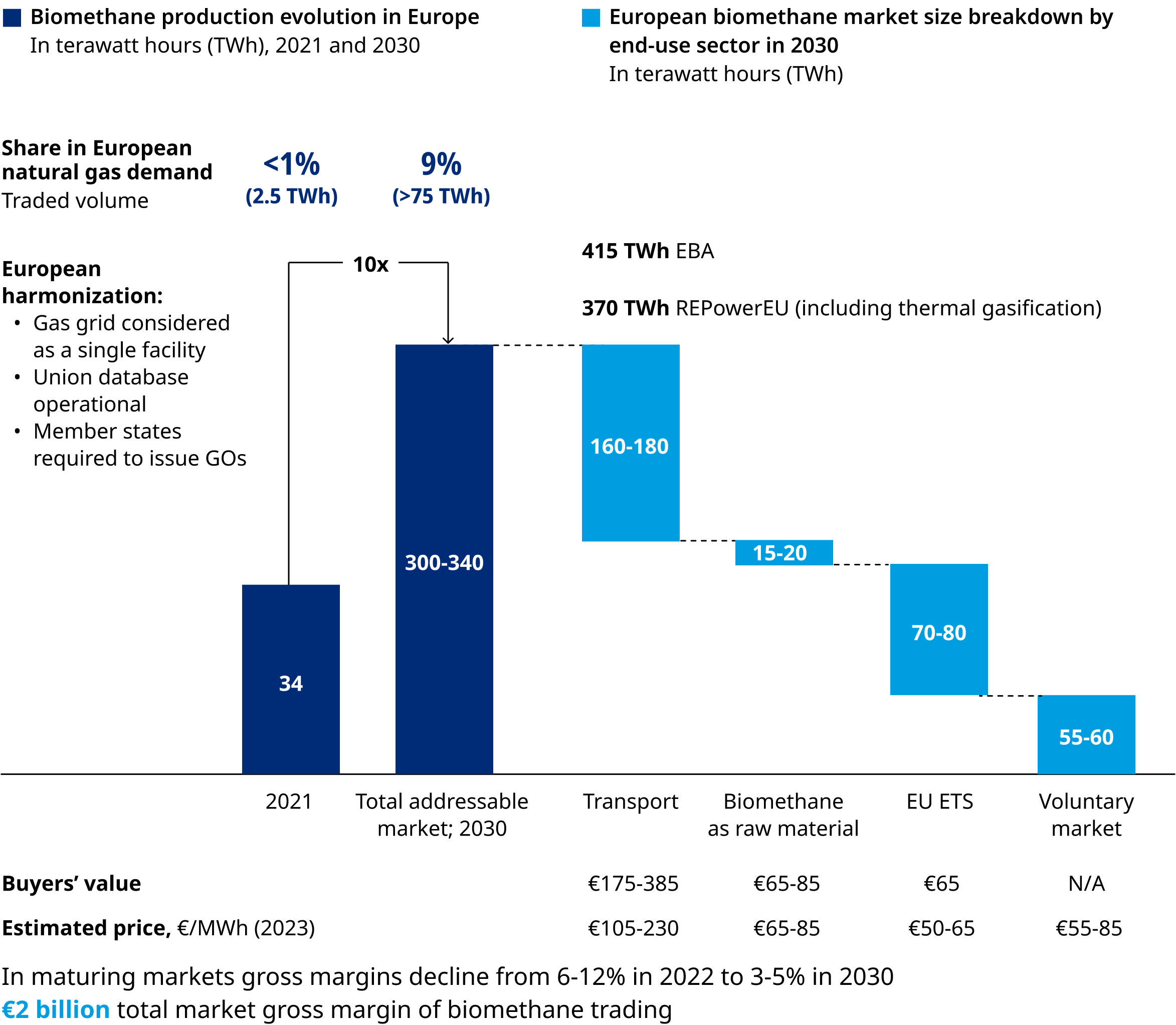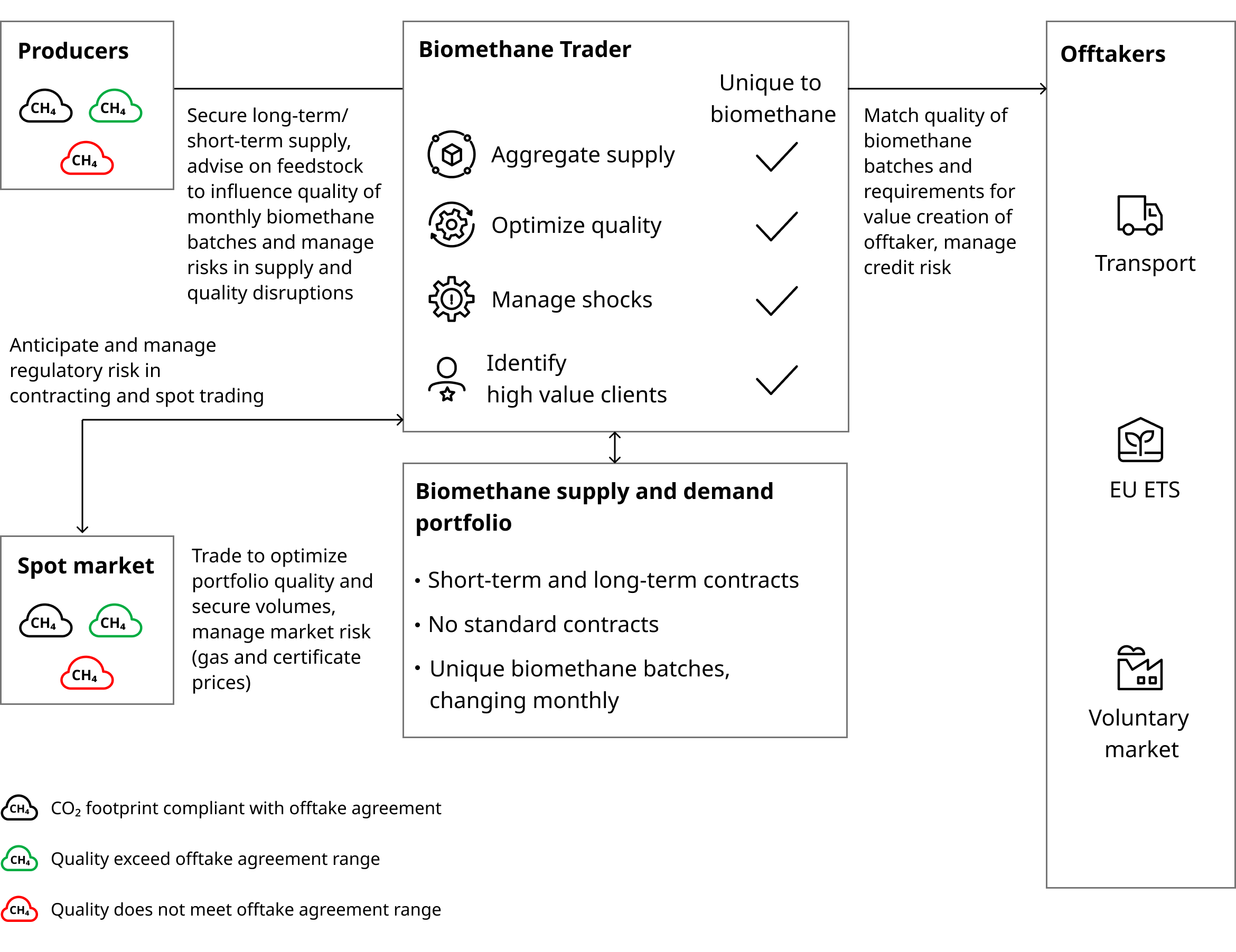Biomethane presents one of the fastest-growing opportunities in commodity trading today. Produced by converting organic waste and feedstock into methane, it has emerged as a promising solution in sustainably fuelling transportation,industry, and dispatchable electricity production. With decarbonization imperatives driving demand and corresponding acceleration in supply, European production of biomethane is expected to grow tenfold by 2030. As a result, traders have an enormous volume and margin opportunity, driven by three key factors: rapid market growth, feedstock and end-user diversity, and opportunities to define the landscape. Taken together, these factors imply a gross trading margin of €2 billion.
The benefits of biomethane
The most significant force for change in the energy sector is the imperative to decarbonize. In the race to slash carbon emissions, governments and corporations are constantly looking for new tools to add to their arsenal. This is especially true for sectors that are more difficult to decarbonize with renewable electricity, like heavy-duty transport and industrial heat. It also applies to the challenge of being able to produce electricity when there is no wind or sun.
Biomethane can be produced from digesting organic waste, such as food, agricultural waste, or manure, or from dedicated food crops. Similarly, city sewage and landfill waste can be converted into biomethane. Such production is carbon neutral since it captures and harnesses existing methane (a potent greenhouse gas) rather than emitting additional greenhouse gases through burning natural gas from the ground. Even better, once processed, biomethane can be used for the same applications and in the same infrastructure as conventional natural gas, making it desirable and economical for end-users to switch.
Three main factors why biomethane is the next big thing for commodity traders
1. There has been rapid growth of biomethane in addressable markets
The combination of transport and industrial demand, political commitments, and investment desire will create significantly higher demand for biomethane. In response, European energy companies are committed to making significant investments to developing biomethane projects and capture value from the combination of carbon neutrality and circularity. These industry commitments and government policies are driving a tenfold increase in the European biomethane market, reaching a total addressable market of 300 to 340 terrawatt-hours (TWh) by 2030 (or about 1000 to 1100 billion cubic feet [BCF]). By comparison, the EU Hydrogen Strategy targets the production of 394 TWh of renewable hydrogen (about 1300 BCF in natural gas equivalents) in the same year. European biomethane production will be traded and cross border trade will grow from 2.5 TWh today to 75 to 150 TWh in 2030.
The addressable market is split by four end-use sectors: transportation, biomethane as raw material, the EU Emissions Trading System, and the voluntary market. The largest of these sectors, accounting for more than half of 2030 demand, is the transport sector, which is focused on using biomethane to replace existing consumption of compressed natural gas (CNG) and liquefied natural gas (LNG) and create new demand for this zero-carbon fuel. End-users are also seeking to prove to stakeholders that sufficient biomethane of European or local origin can be produced to foster further adoption. This is especially important in use cases where technological alternatives are not expected to be cost-competitive or technologically mature enough for the foreseeable future.
From an investment point of view, several players, including oil and gas companies, industrial gas users, and investment funds, have committed significant capital to develop the biomethane market. This reflects a desire to capitalize on existing expertise, invest in a growing market, and align investments with sustainability priorities.

2. There is feedstock and end-user diversity
Biomethane can be produced — and is demanded — at a very wide range of carbon intensities, based on the diversity of feedstock and differentiated end-user requirements. This differentiation unlocks higher margins, as traders play the pivotal role in matching supply and demand. Gross margins for biomethane trading today are approximately 6% to 12%, compared to 1% to 2% for conventional LNG trading.
In contrast to conventional LNG and CNG, biomethane production is dependent on several feedstock-related factors that can result in wildly different carbon intensities for production batches.The carbon dioxide intensity of a biomethane batch can even be negative.
For instance, where manure is used as feedstock, it prevents methane from being released in the atmosphere, which has a much greater impact on emissions than using dedicated food crops to create methane. Carbon intensity is the key lever of pricing and the value-in-use of each biomethane molecule, which means that diverse feedstocks can drive opportunities for arbitrage. Traders participate proactively to steer and incentivize the production of batches with the right characteristics, considering the willingness-to-pay of customers as well as feedstock yield, availability, and cost.
3. There are opportunities for commodity traders to define the landscape
At present, the biomethane trading landscape is immature, with a focus on developing business models, trading strategies, and optimizing value chain positioning. Over the coming years the market is expected to consolidate and professionalize, but the current nascency of the market offers opportunities for traders to get in early and help shape it as it grows. It also offers opportunities to capture higher gross margins, which are expected to halve by 2030 as the market matures.
The state of the market offers ample opportunities for traders to add value, especially given the unique local and decentralized supply chain, specific needs from different end-user types, and certification requirements. Beyond growth appetite, reasons to start trading biomethane include value protection, retaining the upper hand amid future consolidation, and the ability to reduce the carbon intensity of energy product sales in line with their own commitments.
The value from trading will be unlocked by players who can tame the current complexity of the market. Creating pan-European low-carbon optimization systems to efficiently manage regional sub-systems could lead to significant opportunities. Players with a proven track record of aggregating and efficiently managing regional sub-systems in an integrated portfolio are best positioned to take advantage of this opportunity.
What the growing biomethane market means for commodity traders
By 2030, the biomethane market will look very different. There will be an immense opportunity for traders to create a foothold in a key commodity for decarbonization and help construct pan-European optimization systems that become a structural part of a growing market.

Early participation in the market can create enormous future value, and it is not just independent commodity traders who can benefit. The wide range of feedstock sources means that the agricultural industry, municipal governments, and waste management services are all potential participants. The future looks bright for biomethane, not only in the commodity traders’ portfolio, but in transforming sectors and significantly reducing emissions for a lower-carbon world.


